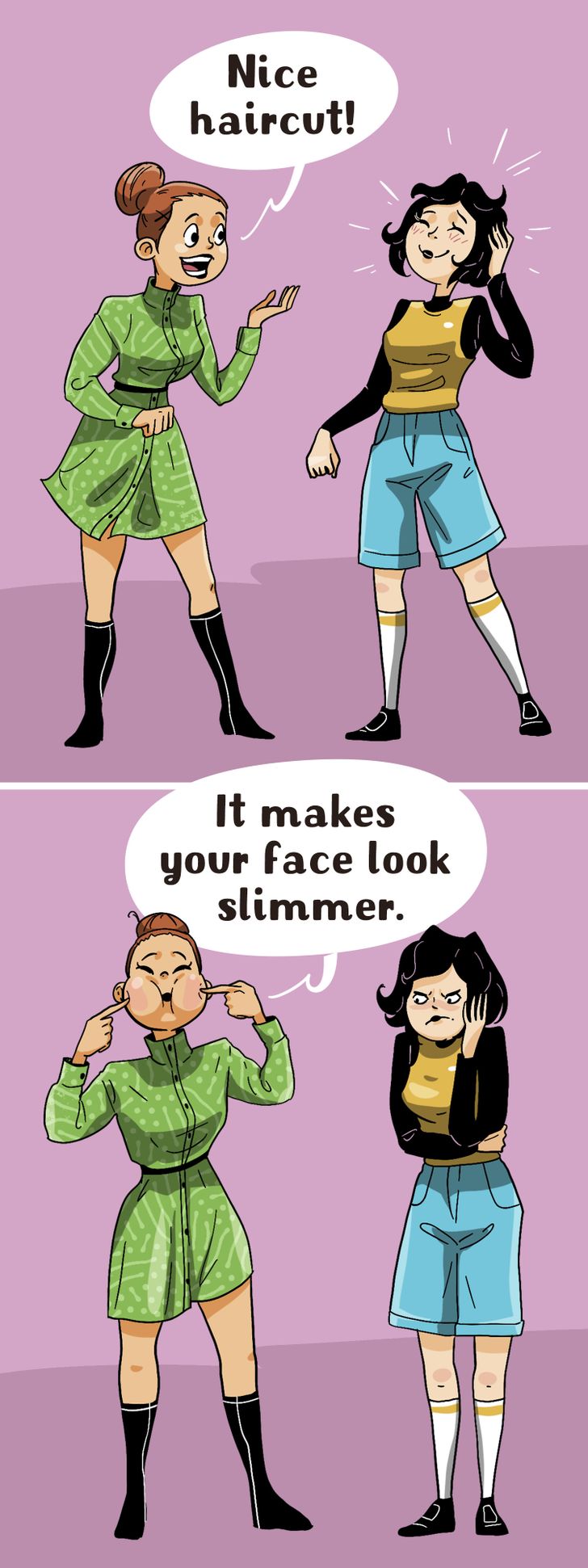“She Needs to Keep Doing,” Pierce Brosnan’s Wife Continues to Shock With Her Transformation


“Wow, you look amazing today! Makeup truly has a way of transforming anyone.” At first glance, this might seem like a genuine compliment, but it’s actually a classic example of a backhanded compliment. While it appears flattering, it’s subtly undermining, suggesting that the person’s natural look is less impressive. Similarly, statements like, “I admire how you can be so direct. I prefer to keep things diplomatic,” can be more challenging to identify as backhanded. These comments seem positive but often carry an underlying critique that reveals more than they initially convey.
Today, we delve into various remarks that are disguised as compliments but often carry an underlying insult. We also provide tips on how to handle these backhanded comments gracefully.

Response: “Thank you. But I think age is just a number.”
Explanation: This response acknowledges the compliment while addressing any potential age-related implication. It reaffirms that looking great is not dependent on age, and reinforces the idea that personal appearance and value aren’t limited by how old someone is.

Response: “Thank you. I do look much better in real life, don’t I?”
Explanation: This response acknowledges the compliment while subtly addressing the implication that the picture doesn’t capture the person’s true appearance. It playfully asserts that the person looks even better in person, which can help counteract any negative undertones and also invites a reaction to gauge the intent behind the comment.

Response: “Are you having a bad day?”
Explanation: This response shifts the focus from the comment about wearing anything to the commenter’s mood. It subtly addresses any negative undertones by suggesting that their comment might be influenced by their own feelings, while also redirecting the conversation away from the personal critique.

Response: “The hairdresser is really good!”
Explanation: This response acknowledges the compliment while subtly redirecting the focus to the positive aspect of the haircut itself. It helps counter any potential underlying criticism about face shape by emphasizing the skill of the hairdresser, which keeps the conversation on a positive note and reinforces the value of the haircut.

Response: “I appreciate your support. I believe that trying and growing is more important than being perfect.”
Explanation: By appreciating the support and emphasizing the value of effort and growth over perfection, this response reframes the compliment to focus on the importance of continual improvement rather than current skill level.

Response: “Thanks! See, I didn’t give up because I knew you were wrong.”
Explanation: This response acknowledges the comment while asserting confidence and resilience. It subtly addresses any implied criticism by highlighting that the person’s efforts and success are proof of overcoming doubts or negativity. This approach reaffirms self-worth and turns the conversation into a positive affirmation of perseverance.

Response: “Thank you! Your parents must have had good fashion sense.”
Explanation: This response acknowledges the comment while turning the focus back to the person giving the compliment. It subtly counters any belittling implication about the choice of dress by making a light-hearted remark about their own fashion sense. This approach deflects negativity and adds a touch of humor to the interaction.

Response: “Thanks! I think this size actually fits me perfectly and makes me feel great.”
Explanation: This response acknowledges the comment while positively framing the clothing size. It shifts the focus from any potential negativity about the size to how well it suits and flatters you, reinforcing self-confidence and turning the conversation into a positive affirmation of personal style.

Response: “That’s so sweet, I didn’t know I already sound like an actual singer!”
Explanation: This response acknowledges the compliment and focuses on the positive aspect of being compared to a singer. It gently deflects the negative implication in the second part of the comment by emphasizing the compliment and expressing appreciation, while also playfully affirming the compliment’s intent.

If a friend were to make a backhanded compliment like, “You’re really good at hiding your imperfections with makeup,” they might be implying that the girl’s natural look isn’t as flattering and that she relies heavily on makeup.
Response: “Thanks! I think makeup is a fun way to express myself and enhance my look, but I’m also comfortable with how I look without it.”
Explanation: This reply acknowledges the compliment while highlighting the positive aspect of makeup as a form of self-expression. It also subtly reinforces confidence in her natural appearance, countering any implication that she is only valuable or attractive due to makeup.

Response: “Sure, but luck is nothing without great effort.”
Explanation: This response acknowledges the comment while emphasizing that effort plays a crucial role in success. It counters the implication that hard work isn’t a factor by asserting that luck alone isn’t sufficient without the dedication and effort that contributed to the achievement.

Response: “It’s important to make time if something is worth it. Maybe I wanted it more.”
Explanation: This response acknowledges the comment while emphasizing that prioritizing and dedicating time to something reflects personal commitment and desire. It addresses the implication that success is only due to having more free time by highlighting that passion and effort often drive achievement, regardless of the circumstances.

Response: “Wouldn’t trade that for anything else.”
Explanation: This response acknowledges the comment while affirming the value of the complimented quality or achievement. It subtly addresses the potential consolation aspect by emphasizing that the particular quality or achievement is highly valued and not seen as a mere consolation. This approach maintains a positive tone and reinforces the worth of what is being complimented.

Response: “It’s not what you’ve got, but what you do with what you’ve got.”
Explanation: This response acknowledges the comment while addressing the underlying implication that success is due to having certain advantages rather than personal effort. It reinforces the idea that achievement comes from how one utilizes their resources and talents, rather than just the resources themselves. This approach helps shift the focus back to the value of hard work and skill.

Response: “I appreciate your kind words. I do try to focus on the positives while working on areas for improvement.”
Explanation: This response accepts the compliment and clarifies that focusing on positives is coupled with ongoing efforts to improve. It addresses the underlying critique by emphasizing personal development and a balanced view of one’s flaws.

Response: “He sure is cute, but I’ll make sure to teach him to be kind to people too.”
Explanation: This response acknowledges the compliment about the baby’s cuteness while subtly addressing any negative implication about not sharing physical features. It shifts the focus to positive parenting by emphasizing the importance of kindness, thus reinforcing a constructive and loving approach to child-rearing.

Response: “I didn’t need any tricks to find someone who truly loves me and wants to marry me.”
Explanation: This response addresses the comment by affirming that the relationship is genuine and based on mutual love, rather than any manipulative tactics. It subtly counters the implication that you don’t deserve your partner by emphasizing the authenticity and strength of the relationship.

Response: “Thank you. But I think you meant to say, ’You’re a strong woman.’”
Explanation: This response acknowledges the compliment while gently correcting the underlying assumption that women are generally weak. It reaffirms strength and capability, addressing any inadvertent stereotype and steering the conversation towards a more empowering perspective.

Response: “But don’t I look beautiful on other days too?”
Explanation: This response acknowledges the compliment while playfully addressing the implication that beauty is limited to just today. It turns the conversation into a light-hearted exchange, reinforcing that the complimented quality extends beyond the specific day mentioned.

Response: “I appreciate your support. I believe that trying and growing is more important than being perfect.”
Explanation: By appreciating the support and emphasizing the value of effort and growth over perfection, this response reframes the compliment to focus on the importance of continual improvement rather than current skill level.

Response: “Thank you! I’m proud of how I’m embracing my new body and feeling confident in my choices.”
Explanation: This response acknowledges the compliment while shifting the focus to the positive aspect of self-confidence and body acceptance. It addresses the underlying critique by expressing pride in embracing and feeling confident about her appearance, regardless of any implied judgment.
Curious about how to handle other awkward or backhanded comments? Discover more effective comebacks that’ll leave rude commenters speechless in our article.











